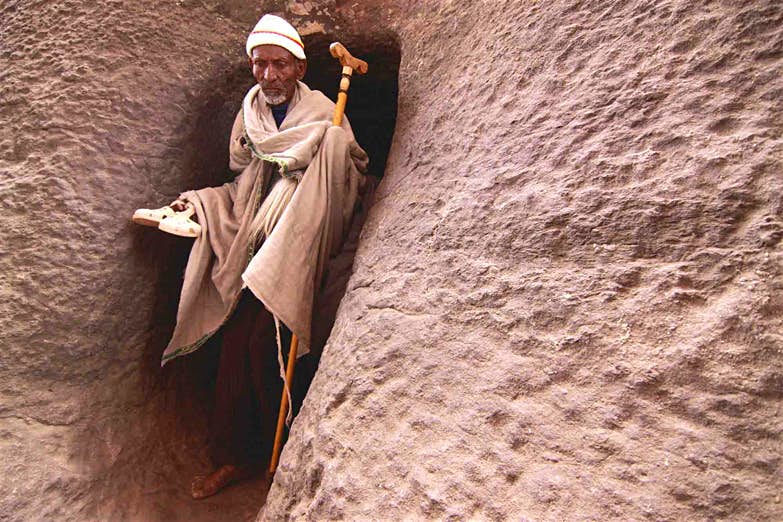Ethiopia has the ability to wow you day after day. This is truly a world apart; there are more than two millennia worth of ancient treasures scattered around Ethiopia, from the giant obelisks and hidden tombs of the legendary Queen of Sheba, to castles that would make Camelot jealous and the breathtaking rock-carved churches of Lalibela.
Not to be outdone by human craftsmen, Mother Nature really let her creative juices flow in Ethiopia. East Africa’s Rift Valley has left some of its most memorable signatures here: volcanoes bubble and boil, lakes are the colour of English tea and deep canyons and steep peaks wrinkle the land…well, just about everywhere. Starting with the best known and ending with those often unknown to even veteran Ethiopian travellers, here’s our list of the signature sights of Ethiopia.

A pilgrim emerges from a tunnel into the courtyard of a church in Lalibela. Image by Stuart Butler / Lonely Planet.
Lalibela
Nearly a thousand years ago, a poisoned king was taken by angels to heaven. Here he was shown a city of rock-hewn churches. Then God himself commanded him to return to Earth and, recreating what he had seen, build a New Jerusalem. Today, that New Jerusalem is called Lalibela and to visit it is to immerse yourself in Christianity in its most raw and powerful form.
Aksum
Aksum is a riddle waiting to be solved. Did the Queen of Sheba really call the town’s dusty streets home? Does the very same Ark of the Covenant that Moses carried down from Mt Sinai reside in that small chapel? Are there actually secret hordes of treasure hidden inside undiscovered tombs? And just what exactly do those famous stelae signify? This Unesco World Heritage Site is undoubtedly one of the most important and spectacular ancient sites in sub-Saharan Africa – as well as one of the least understood.

A priest at the Abba Pentalewon monastery near Aksum. Image by Stuart Butler / Lonely Planet.
Gonder
Gonder is often called the ‘Camelot of Africa’ on account of its magnificent collection of turreted castles painted in the pomp of royalty and bathed in the blood of treachery. The castles, churches and other royal sites of Gonder, most of which date from between the 17th and 18th centuries, are a Unesco World Heritage Site and of all Ethiopia’s historic sites they are probably second only to Lalibela in regards to immediate visual impact.
Simien Mountains National Park
The Simien Mountains, a massive table of rock up to 4500m high and riven with gullies, offers easy but immensely rewarding hiking along the edge of a plateau that falls sheer to the plains far below. These mountains are also home to huge groups gelada monkeys as well as magnificent walia ibex.
Churches of Tigray
The mountains of northern Ethiopia are home to hundreds of ancient monasteries. Some require scrambles up sheer rock faces to reach, some are invisible and guarded by sword-wielding ghosts, some contain the bones of former monks and one could only be built with the help of a giant snake.

A Surmi man on the western side of the Omo valley. Image by Stuart Butler / Lonely Planet.
Lower Omo Valley
Whether it’s wandering through traditional Konso villages, watching Hamer people performing a jumping of the bulls ceremony or admiring the Mursi’s mind-blowing lip plates, a visit to the Omo Valley will stick with you for a lifetime. But come quick, because a series of mega development projects will, for better or worse (and the jury is still very much out on this count), bring huge changes to Omo and its people over the next few years.
Harar
The ancient walled city of Harar is eastern Ethiopia’s number one tourist drawcard. The old quarter, which is more reminiscent of a Middle Eastern souk than an Ethiopian town, is a maze of narrow, twisting alleys, replete with historic buildings, including 82 small mosques, numerous shrines and tombs, as well as traditional Harari houses.

A young Surmi boy drinks fresh cows blood. Image by Stuart Butler / Lonely Planet.
Danakil Depression
Bubbling volcanoes light up the night sky, sulphurous mounds of yellow contort into otherworldly shapes, mirages of camels cross lakes of salt and proud Afar warriors stride away into the horizons haze. Lying 100m and more below sea level, the Danakil Depression is about the hottest and most inhospitable place on earth. If you want genuine, raw adventure, then few corners of the globe can match this overwhelming wilderness. But come prepared – conditions are extreme and security issues can be a real worry.
Bale Mountains
Wrongly playing second fiddle to the better known Simien Mountains, the Bale Mountains National Park might not be as well-known as its bigger brother, but in many ways it’s the more interesting park. The wild, drizzly moorlands, alpine lakes and gushing streams are starkly beautiful, the hiking fabulous and if you want to see the world’s rarest canine, the Ethiopian Wolf, then there is simply no better place in which to meet them.
This article was kindly republished from: Lonely Planet


Leave a Reply
You must be logged in to post a comment.